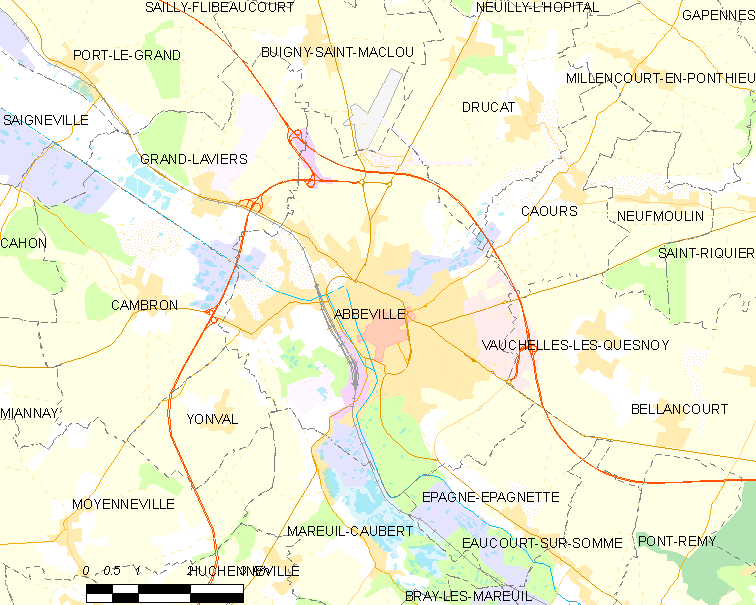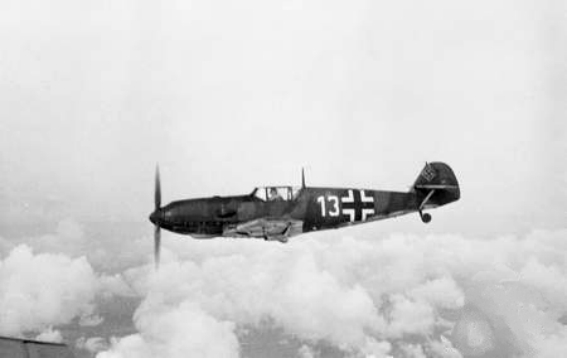|
Aerodrome Abbeville
The Aerodrome Abbeville (french: Aérodrome d'Abbeville) or Abbeville Airport, , is an airport serving Abbeville and located in Buigny-Saint-Maclou, north-northeast of Abbeville, both ''communes'' of the Somme ''département'' in the Picardie ''région'' of France. History It is not known when exactly the airfield was built, but it was in use with the British Expeditionary Forces in 1940. Detachments of No. 607 Squadron RAF with Gloster Gladiator biplanes were based here along with No. 151 Squadron RAF Hawker Hurricanes before they were withdrawn to English bases in June 1940 during the Battle of France. It was seized by the Luftwaffe and became a German Fliegerhorst. The Luftwaffe immediately began preparing for the Battle of Britain and the airfield became home to Zerstörergeschwader 76 (ZG 76) with Bf 110Cs, and later Fw 190As of II./ Jagdgeschwader 26 (JG 26) 'Schlageter' in December 1941. Judging from the layout of the airfield, it was the Luftwaffe that upgraded the ai ... [...More Info...] [...Related Items...] OR: [Wikipedia] [Google] [Baidu] |
Abbeville
Abbeville (, vls, Abbekerke, pcd, Advile) is a commune in the Somme department and in Hauts-de-France region in northern France. It is the chef-lieu of one of the arrondissements of Somme. Located on the river Somme, it was the capital of Ponthieu. Its inhabitants are called the ''Abbevillois''. Geography Location Abbeville is located on the river Somme, from its modern mouth in the English Channel. The majority of the town is located on the east bank of the Somme, as well as on an island. It is located at the head of the Abbeville Canal, and is northwest of Amiens and approximately from Paris. It is also as the crow flies from the and the English Channel. In the medieval period, it was the lowest crossing point on the Somme and it was nearby that Edward III's army crossed shortly before the Battle of Crécy in 1346. Just halfway between Rouen and Lille, it is the historical capital of the County of Ponthieu and maritime Picardy. Quarters, hamlets and local ... [...More Info...] [...Related Items...] OR: [Wikipedia] [Google] [Baidu] |
Battle Of Britain
The Battle of Britain, also known as the Air Battle for England (german: die Luftschlacht um England), was a military campaign of the Second World War, in which the Royal Air Force (RAF) and the Fleet Air Arm (FAA) of the Royal Navy defended the United Kingdom (UK) against large-scale attacks by Nazi Germany's air force, the Luftwaffe. It was the first major military campaign fought entirely by air forces."92 Squadron – Geoffrey Wellum." ''Battle of Britain Memorial Flight'' via ''raf.mod.uk.''. Retrieved: 17 November 2010, archived 2 March 2009. The British officially recognise the battle's duration as being from 10 July until 31 October 1940, which overlaps the period of large-scale night attacks known as |
Concrete
Concrete is a composite material composed of fine and coarse aggregate bonded together with a fluid cement (cement paste) that hardens (cures) over time. Concrete is the second-most-used substance in the world after water, and is the most widely used building material. Its usage worldwide, ton for ton, is twice that of steel, wood, plastics, and aluminum combined. Globally, the ready-mix concrete industry, the largest segment of the concrete market, is projected to exceed $600 billion in revenue by 2025. This widespread use results in a number of environmental impacts. Most notably, the production process for cement produces large volumes of greenhouse gas emissions, leading to net 8% of global emissions. Other environmental concerns include widespread illegal sand mining, impacts on the surrounding environment such as increased surface runoff or urban heat island effect, and potential public health implications from toxic ingredients. Significant research and development is ... [...More Info...] [...Related Items...] OR: [Wikipedia] [Google] [Baidu] |
Runway
According to the International Civil Aviation Organization (ICAO), a runway is a "defined rectangular area on a land aerodrome prepared for the landing and takeoff of aircraft". Runways may be a man-made surface (often asphalt concrete, asphalt, concrete, or a mixture of both) or a natural surface (sod, grass, soil, dirt, gravel, ice, sand or road salt, salt). Runways, as well as taxiways and Airport apron, ramps, are sometimes referred to as "tarmac", though very few runways are built using Tarmacadam, tarmac. Takeoff and landing areas defined on the surface of water for seaplanes are generally referred to as waterways. Runway lengths are now International Civil Aviation Organization#Use of the International System of Units, commonly given in meters worldwide, except in North America where feet are commonly used. History In 1916, in a World War I war effort context, the first concrete-paved runway was built in Clermont-Ferrand in France, allowing local company Michelin to ... [...More Info...] [...Related Items...] OR: [Wikipedia] [Google] [Baidu] |
Mean Sea Level
There are several kinds of mean in mathematics Mathematics is an area of knowledge that includes the topics of numbers, formulas and related structures, shapes and the spaces in which they are contained, and quantities and their changes. These topics are represented in modern mathematics ..., especially in statistics. Each mean serves to summarize a given group of data, often to better understand the overall value (magnitude (mathematics), magnitude and sign (mathematics), sign) of a given data set. For a data set, the ''arithmetic mean'', also known as "arithmetic average", is a measure of central tendency of a finite set of numbers: specifically, the sum of the values divided by the number of values. The arithmetic mean of a set of numbers ''x''1, ''x''2, ..., x''n'' is typically denoted using an overhead bar, \bar. If the data set were based on a series of observations obtained by sampling (statistics), sampling from a statistical population, the arithmetic mean is th ... [...More Info...] [...Related Items...] OR: [Wikipedia] [Google] [Baidu] |
Elevation
The elevation of a geographic location is its height above or below a fixed reference point, most commonly a reference geoid, a mathematical model of the Earth's sea level as an equipotential gravitational surface (see Geodetic datum § Vertical datum). The term ''elevation'' is mainly used when referring to points on the Earth's surface, while ''altitude'' or ''geopotential height'' is used for points above the surface, such as an aircraft in flight or a spacecraft in orbit, and '' depth'' is used for points below the surface. Elevation is not to be confused with the distance from the center of the Earth. Due to the equatorial bulge, the summits of Mount Everest and Chimborazo have, respectively, the largest elevation and the largest geocentric distance. Aviation In aviation the term elevation or aerodrome elevation is defined by the ICAO as the highest point of the landing area. It is often measured in feet and can be found in approach charts of the aerodrome. It is n ... [...More Info...] [...Related Items...] OR: [Wikipedia] [Google] [Baidu] |
Operation Varsity
Operation Varsity (24 March 1945) was a successful airborne forces operation launched by Allied troops that took place toward the end of World War II. Involving more than 16,000 paratroopers and several thousand aircraft, it was the largest airborne operation in history to be conducted on a single day and in one location. ''Varsity'' was part of Operation Plunder, the Anglo-American-Canadian assault under Field Marshal Bernard Montgomery to cross the northern Rhine River and from there enter Northern Germany. ''Varsity'' was meant to help the surface river assault troops secure a foothold across the Rhine River in Western Germany by landing two airborne divisions on the eastern bank of the Rhine near the village of Hamminkeln and the town of Wesel. The plans called for the dropping of two divisions from U.S. XVIII Airborne Corps, under Major General Matthew B. Ridgway, to capture key territory and to generally disrupt German defenses to aid the advance of Allied ground forces. ... [...More Info...] [...Related Items...] OR: [Wikipedia] [Google] [Baidu] |
C-47 Skytrain
The Douglas C-47 Skytrain or Dakota (Royal Air Force, RAF, Royal Australian Air Force, RAAF, Royal Canadian Air Force, RCAF, Royal New Zealand Air Force, RNZAF, and South African Air Force, SAAF designation) is a airlift, military transport aircraft developed from the civilian Douglas DC-3 airliner. It was used extensively by the Allies of World War II, Allies during World War II and remained in front-line service with various military operators for many years.Parker 2013, pp. 13, 35, 37, 39, 45-47. Design and development The C-47 differed from the civilian DC-3 by way of numerous modifications, including being fitted with a cargo door, hoist attachment and strengthened floor - along with a shortened tail cone for Military glider, glider-towing shackles, and an Astrodome (aeronautics), astrodome in the cabin roof.Wilson, Stewart. ''Aircraft of WWII''. Fyshwick, ACT, Australia: Aerospace Publications Pty Ltd., 1998. . During World War II, the armed forces of many countries used ... [...More Info...] [...Related Items...] OR: [Wikipedia] [Google] [Baidu] |
Bf 109
The Messerschmitt Bf 109 is a German World War II fighter aircraft that was, along with the Focke-Wulf Fw 190, the backbone of the Luftwaffe's fighter force. The Bf 109 first saw operational service in 1937 during the Spanish Civil War and was still in service at the end of World War II in 1945. It was one of the most advanced fighters when it first appeared, with an all-metal monocoque construction, a closed canopy, and retractable landing gear. It was powered by a liquid-cooled, inverted-V12 aero engine. It was called the Me 109 by Allied aircrew and some German aces, even though this was not the official German designation. It was designed by Willy Messerschmitt and Robert Lusser who worked at Bayerische Flugzeugwerke during the early to mid-1930s. It was conceived as an interceptor, although later models were developed to fulfill multiple tasks, serving as bomber escort, fighter-bomber, day-, night-, all-weather fighter, ground-attack aircraft, and reconnaissance ... [...More Info...] [...Related Items...] OR: [Wikipedia] [Google] [Baidu] |
Jagdgeschwader 26
''Jagdgeschwader'' 26 (JG 26) ''Schlageter'' was a German fighter-wing of World War II. It was named after Albert Leo Schlageter, a World War I veteran, Freikorps member, and posthumous Nazi martyr, arrested and executed by the French for sabotage in 1923. The wing fought predominantly against the Western Allies. Formed in May 1939, JG 26 spent the Phoney War period guarding Germany's western borders following the German invasion of Poland and the outbreak of World War II. In May and June 1940 it served in the Battle of Belgium and Battle of France. From July 1940 it operated over England in the Battle of Britain under the command of Adolf Galland, future ''General der Jagdflieger''. JG 26 remained in France and Belgium fighting against the RAF Fighter Command Circus offensive in 1941 and 1942, with considerable tactical success. In 1943 it faced the USAAF Eighth Air Force, and along with the rest of the Luftwaffe fighter force, was worn down over Western Europe ... [...More Info...] [...Related Items...] OR: [Wikipedia] [Google] [Baidu] |
Fw 190
The Focke-Wulf Fw 190, nicknamed ''Würger'' (" Shrike") is a German single-seat, single-engine fighter aircraft designed by Kurt Tank at Focke-Wulf in the late 1930s and widely used during World War II. Along with its well-known counterpart, the Messerschmitt Bf 109, the Fw 190 became the backbone of the (Fighter Force) of the . The twin-row BMW 801 radial engine that powered most operational versions enabled the Fw 190 to lift larger loads than the Bf 109, allowing its use as a day fighter, fighter-bomber, ground-attack aircraft and to a lesser degree, night fighter. The Fw 190A started flying operationally over France in August 1941 and quickly proved superior in all but turn radius to the Spitfire Mk. V, the main front-line fighter of the Royal Air Force (RAF), particularly at low and medium altitudes. The 190 maintained superiority over Allied fighters until the introduction of the improved Spitfire Mk. IX. In November/December 1942, the Fw 190 made its air combat ... [...More Info...] [...Related Items...] OR: [Wikipedia] [Google] [Baidu] |








.jpg)